#The Mount of Olives
Explore tagged Tumblr posts
Text

'Exquisite' 1,700-Year-Old Lamp Bearing Temple Symbols Discovered in Jerusalem
"The exquisite artistic workmanship of the lamp, which was found complete, makes it outstanding and extremely rare."
A rare ceramic oil lamp dated to the late Roman period that bears images of items used in the Second Temple was discovered in Jerusalem, the Israel Antiquities Authority announced on Thursday.
"After the Roman emperor Hadrian suppressed the Bar Kochba rebellion in 135 CE, Jews were expelled from the city. The Mount of Olives lamp is one of the few material traces of a Jewish presence around Jerusalem in the 3rd-5th centuries CE," said Michael Chernin, excavation director on behalf of the Antiquities Authority.
The Antiquities Authority explained that the lamp was a "unique find" and that, judging by the soot marks on its nozzle, it was used about 1,700 years ago.
The Temple symbols that decorate the lamp include a depiction of the menorah used in the Second Temple, an incense shovel, and lulav (date palm branch used in Jewish ritual).
"The exquisite artistic workmanship of the lamp, which was found complete, makes it outstanding and extremely rare,” said Chernin.
Chernin also explained that the symbols on the lamp, which connected them to the Temple, were "particularly surprising" because there has been "very little evidence of the existence of a Jewish settlement in and around Jerusalem from this period."
Israel Antiquities Authority research archaeologist Benjamin Storchan said the lamp belongs to "the 'Beit Nattif' type, named after a production workshop identified in the 1930s near Bet Shemesh."

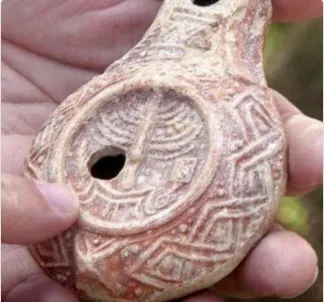
'Exceedingly rare' find
He explained that "oil lamps with menorah decorations are exceedingly rare, and only a few similar Beit Nattif-type lamps can be found in the National Treasures archive. The choice of symbols on the lamp is not accidental. This is a fascinating testimony connecting everyday objects and faiths among ancient Jerusalem’s inhabitants. It seems that the lamp belonged to a Jew, who purchased it because of its religious affiliation and memorial to the Temple.”
"It is evident that the lamp maker dedicated a great deal of time and effort to its decoration," Storchan added.
He then continued to elaborate on how the lamp was made, saying the maker "delicately and intricately carved limestone molds using drills and chisels."


"The molds were made in two parts (upper and lower). To create the lamp, the potter pressed the clay into the molds and then pressed them together. Finally, the vessel was fired, and it could be used. This method of producing lamps in molds allowed for refined designs, as well as the addition of delicate and intricate decorations," Storchan continued.
Heritage Minister Rabbi Amichai Eliyahu remarked on the correlation between the time of the finding and the Jewish holiday of Hanukkah.
"This unique oil lamp, which in an exciting manner bears the symbols of the Temple, connects the lights of the past with the Hannukah holiday of today and expresses the deep and long-standing connection of the nation of Israel to its heritage and to the Temple’s memory.”
Rabbi Eliyahu also stated that the lamp would be revealed to the public for the first time during Hannukah "alongside stone molds used to make ceramic lamps."
#'Exquisite' 1700-Year-Old Lamp Bearing Temple Symbols Discovered in Jerusalem#The Mount of Olives#ancient oil lamp#ancient artifacts#archeology#archeolgst#history#history news#ancient history#ancient culture#ancient civilizations#ancient israel#ancient art
30 notes
·
View notes
Text

Ascension chapel on the Mount of Olives in Jerusalem, Palestine
French vintage postcard
#tarjeta#postkaart#sepia#the mount of olives#olives#carte postale#ansichtskarte#jerusalem#chapel#ascension#briefkaart#photo#photography#postal#postkarte#vintage#french#mount#postcard#historic#palestine#ephemera
15 notes
·
View notes
Text
John 7:53–8:2
53 Καὶ ἐπορεύθησαν ἕκαστος εἰς τὸν οἶκον αὐτοῦ,
8:1 Ἰησοῦς δὲ ἐπορεύθη εἰς τὸ ὄρος τῶν ἐλαιῶν. 2 Ὄρθρου δὲ πάλιν παρεγένετο εἰς τὸ ἱερὸν καὶ πᾶς ὁ λαὸς ἤρχετο πρὸς αὐτόν, καὶ καθίσας ἐδίδασκεν αὐτούς.
My translation:
53 And each one went to his house,
8:1 but Jesus went to the mountain of olive trees. 2 And when it was morning he again arrived in the temple and all the people came to him, and, having sat, he was teaching them.
Notes:
The differences of vocabulary between the following pericope (7:35 – 8:11) and the rest of this gospel (and the similarities to the synoptics, especially Luke), clearly showing its non-Johannine authorship, are well-illustrated by CGT & ICC and are summarized here:
πορεύομαι εἰς is used once elsewhere in John but 16x in Luke;
terms of the ὄρθρ- root are used nowhere else in John (who prefers πρωΐ) but are used 4x by Luke;
τὸ ὄρος τῶν ἐλαιῶν is used nowhere else in John, but 10x in the synoptics;
λαός is used 2x elsewhere in John, but 14x in Matthew and 36x in Luke;
καθίζω is used 2x elsewhere in John, but 23x in the synoptics;
ὁ γραμματεύς is used nowhere else in John but 57x in the synoptists;
John's favorite particle οὖν is not used at all in the narrative and only once in the dialogue; δὲ is used instead, which is common in Luke;
πειράζω is used 12x in the synoptics of testing Jesus, but never with this usage elsewhere in John.
7:53
The subject of the aorist passive ἐπορεύθησαν (from πορεύομαι; aor. pass. form with mid. dep sense) is the substantival ἕκαστος (“each one”). It is not clear to whom ἕκαστος refers. It could be the people or perhaps the members of the Sanhedrin. The verb is modified by the spatial prepositional phrase εἰς τὸν οἶκον. αὐτοῦ, referring to ἕκαστος, is a possessive genitive.
8:1
Ἰησοῦς is the subject of the aorist passive ἐπορεύθη (from πορεύομαι; aor. pass. form with mid. dep sense) which is modified by the spatial prepositional phrase εἰς τὸ ὄρος τῶν ἐλαιῶν. The genitive τῶν ἐλαιῶν is descriptive. This is the only time the Mount of Olives is mentioned in the gospel of John.
8:2
ὁ ὄρθρος (3x) is, “dawn, early morning” (BDAG). ὄρθρου is a genitive of time modifying the 2nd aorist παρεγένετο (from παραγίνομαι “I come, arrive, am present”) whose unexpressed subject is Jesus. While a dative marks a moment in time and an accusative the extent of time, a genitive of time indicates “the kind of time, or time within which’ the action takes place (Wallace 122). The verb is also modified by the temporal adverb πάλιν and the spatial prepositional phrase εἰς τὸ ἱερὸν.
πᾶς is attributive with ὁ λαὸς (“all the people”), which is the subject of the imperfect ἤρχετο (from ἔρχομαι). The verb is modified by the spatial prepositional phrase πρὸς αὐτόν, referring to Jesus. The imperfect-tense of the verb is progressive, where the singular ὁ λαὸς refers to an ongoing influx of people.
The aorist participle καθίσας (from καθίζω; here intransitive) is temporal-antecedent with the imperfect ἐδίδασκεν (from διδάσκω): “after sitting, he began to teach” (usually translated as an indicative verb: NRSV, NET, HCSB: “he sat down and began to teach them”). αὐτούς, referring to the people, is the direct object of the verb. The imperfect-tense of the verb is inceptive.
0 notes
Text
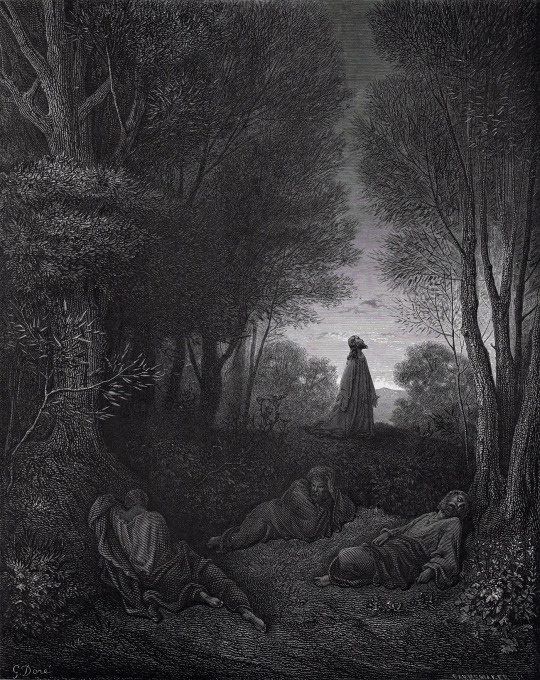
Jesus Praying in the Garden by Gustave Doré
#jesus christ#jesus#christ#art#gustave doré#garden of gethsemane#mount of olives#la grande bible de tours#garden#praying#prayer#agony#peter#john#james#gethsemane#religion#christianity#christian#religious art#bible#biblical#religious#god#james the great#peter the apostle#saint peter#john the apostle#st peter
1K notes
·
View notes
Text

#israel#secular-jew#jewish#judaism#israeli#jerusalem#diaspora#secular jew#secularjew#islam#mount of olives#indigenous#indigenousness#jews are from judea#hamas is isis#Isis#muslim brotherhood#islamism#caliphate#Islam is colonialism#colonial Islam
201 notes
·
View notes
Text


81 notes
·
View notes
Text


mount athos series 424 / olive trees
© 2024 Yiannis Krikis
#mount athos#olive tree#lensblr#lensculture#fine art photography#photographers on tumblr#landscape#greece#vatopedi
55 notes
·
View notes
Text

Frederick Street, Mount Oliver, Pennsylvania.
55 notes
·
View notes
Text




Happy valentines day💕
#jude bellingham#trent alexander arnold#gavi#mason mount#declan rice#kylian mbappe#marco reus#pedri#robert lewandowski#manuel neuer#thomas müller#oliver giroud#jack grealish#jordan henderson#david beckham#harry kane#son heung min#real madrid#liverpool fc#fc barcelona#kevin de bruyne#lionel messi#cristiano
92 notes
·
View notes
Text

Entry of Christ into Jerusalem
Artist: Pieter Coecke van Aelst (Flemish, 1502–1550)
Date: c. 1530
Medium: OIl on Panel
Collection: The Bonnefanten Museum, Maastricht, Netherlands
Description
The triumphal entry of Christ into Jerusalem. Two-sided painting, that used to be a shutter of a large Passion retable, now dismantled. Other panels from this retable are now in Trier, Berlin, Cape Town and Lisbon. On the reverse is a painting of Saint Trudo, which links the retable to Sint-Truiden Abbey.
In the foreground, several figures are cheering Christ on his entry into Jerusalem on a donkey. The Mount of Olives, where Jesus and his disciples have come from can be seen in the distance. The painting gives a very lively impression. The movement in the composition, along with the abundance of human figures and the bright, fresh colours create an exuberant whole. A striking element of this painting is the unusual contortion of the figures. The architecture of the city wall works like a sort of stage set for the scene in the foreground.
John 12:12-13 The next day the great crowd that had come for the festival heard that Jesus was on his way to Jerusalem. They took palm branches and went out to meet him, shouting, “Hosanna! ” “Blessed is he who comes in the name of the Lord!”“Blessed is the king of Israel!”
#painting#christianity#gospel of john#jesus christ#monkey#jerusalem#triumphal entry#donkey#mount of olives#architecture#christian art#biblical scene#peter coecke van aelstabout#flemish painter#european art#olive branches#men#tree#16th century painting
14 notes
·
View notes
Text
beloved disciple nation how we feeling
#brain is melting lines are blurring#mount of olives.... my words will never pass away.........#yeah we in for it#also i guess george read your love by ghostsmp3 thats very neat#something truly so spectacular about john wanting to comfort jesus but i will not get on that soapbox this morning#george xanthis#jonathan roumie#jesus x john#john the apostle#the beloved disciple#the chosen#the chosen tv#religion#the chosen cast#jesus
31 notes
·
View notes
Text

Augusta Victoria Monastery on the Mount of Olives in Jerusalem, Palestine
French vintage postcard
#tarjeta#augusta#olives#jerusalem#postkarte#postkaart#vintage#palestine#french#sepia#photo#the mount of olives#postcard#augusta victoria monastery#postal#historic#victoria#briefkaart#carte postale#monastery#ephemera#ansichtskarte#mount#photography
6 notes
·
View notes
Text
masterlist ♡ football players


Antoine Griezmann (ag7)
blurbs!
More than friends
Fake it till you make it
Have you ever tried this one?
#football players x reader#football#antoine griezmann x reader#mason mount x reader#benjamin pavard x reader#christian pulisic x reader#rodrigo riquelme x reader#rodrigo riquelme#antoine griezmann#christian pulisic#oliver giroud#mariclerc fics
20 notes
·
View notes
Text
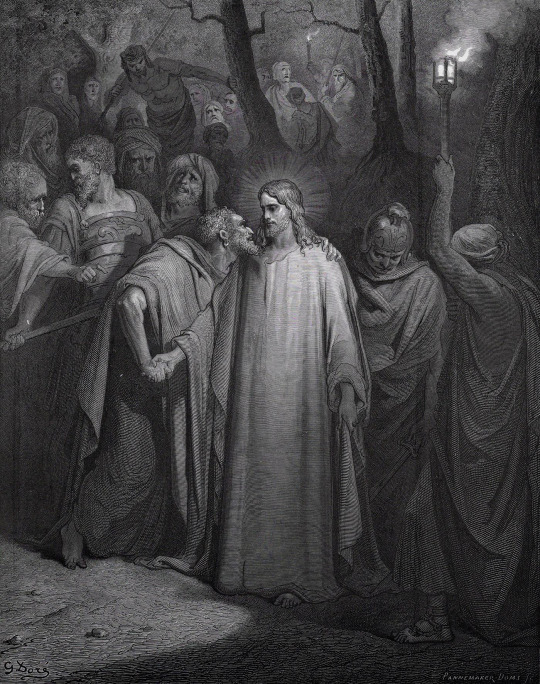
The Judas Kiss by Gustave Doré
#jesus christ#judas#art#gustave doré#judas iscariot#jesus#christ#garden of gethsemane#gethsemane#jerusalem#peter#mount of olives#la grande bible de tours#christianity#christian#religion#religious art#religious#biblical#bible#soldier#soldiers#lanterns#lantern#torch#torches
403 notes
·
View notes
Text
#NoCeasefire
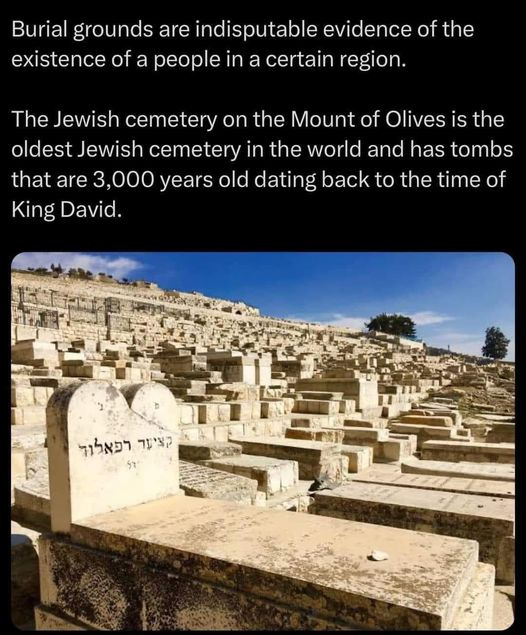
#MOUNT OF OLIVES#israel#secular-jew#jewish#judaism#israeli#jerusalem#diaspora#secular jew#secularjew#islam#INDIGENOUS#indigenous history#indigenous peoples#jewish indigeneity#indigeneity#historic#ancient roots#roots#proof of ancestry#proof of indigenousness#no ceasefire#hamas#palestinian
33 notes
·
View notes
Text
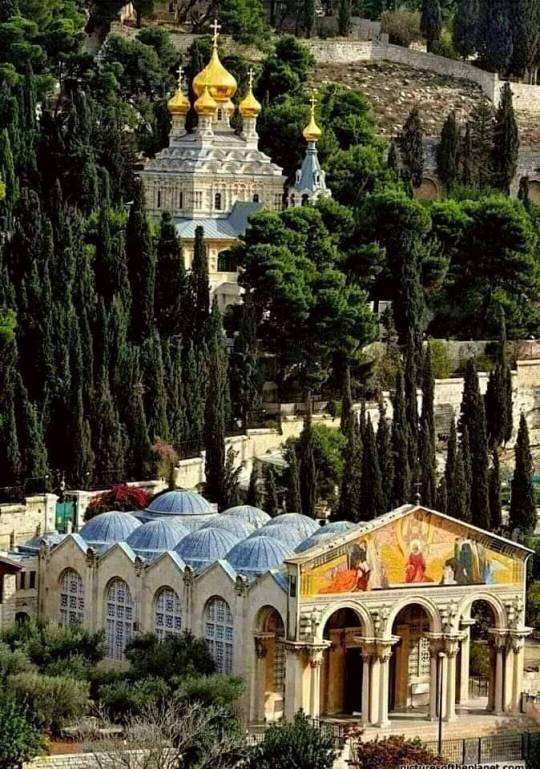
Mount of Olives, Jerusalem, ISRAEL
49 notes
·
View notes